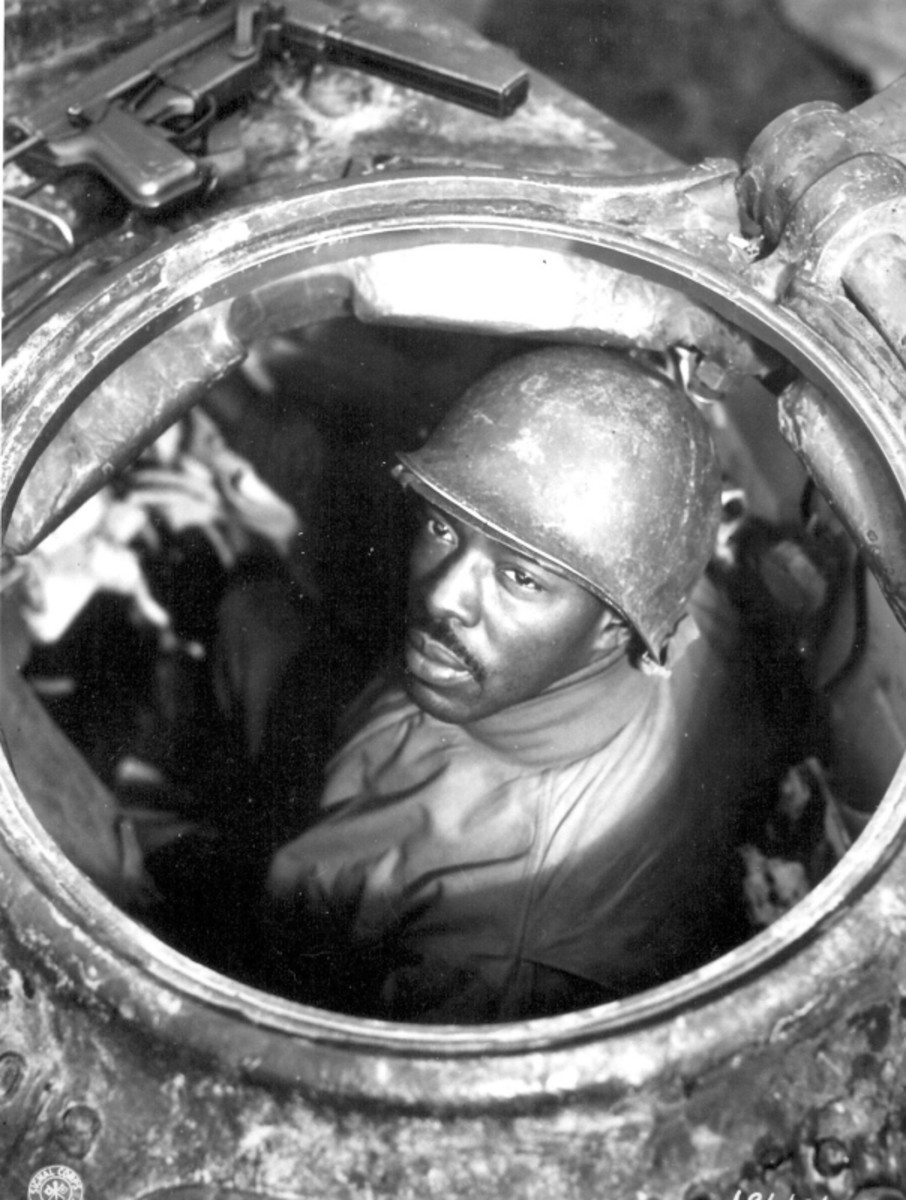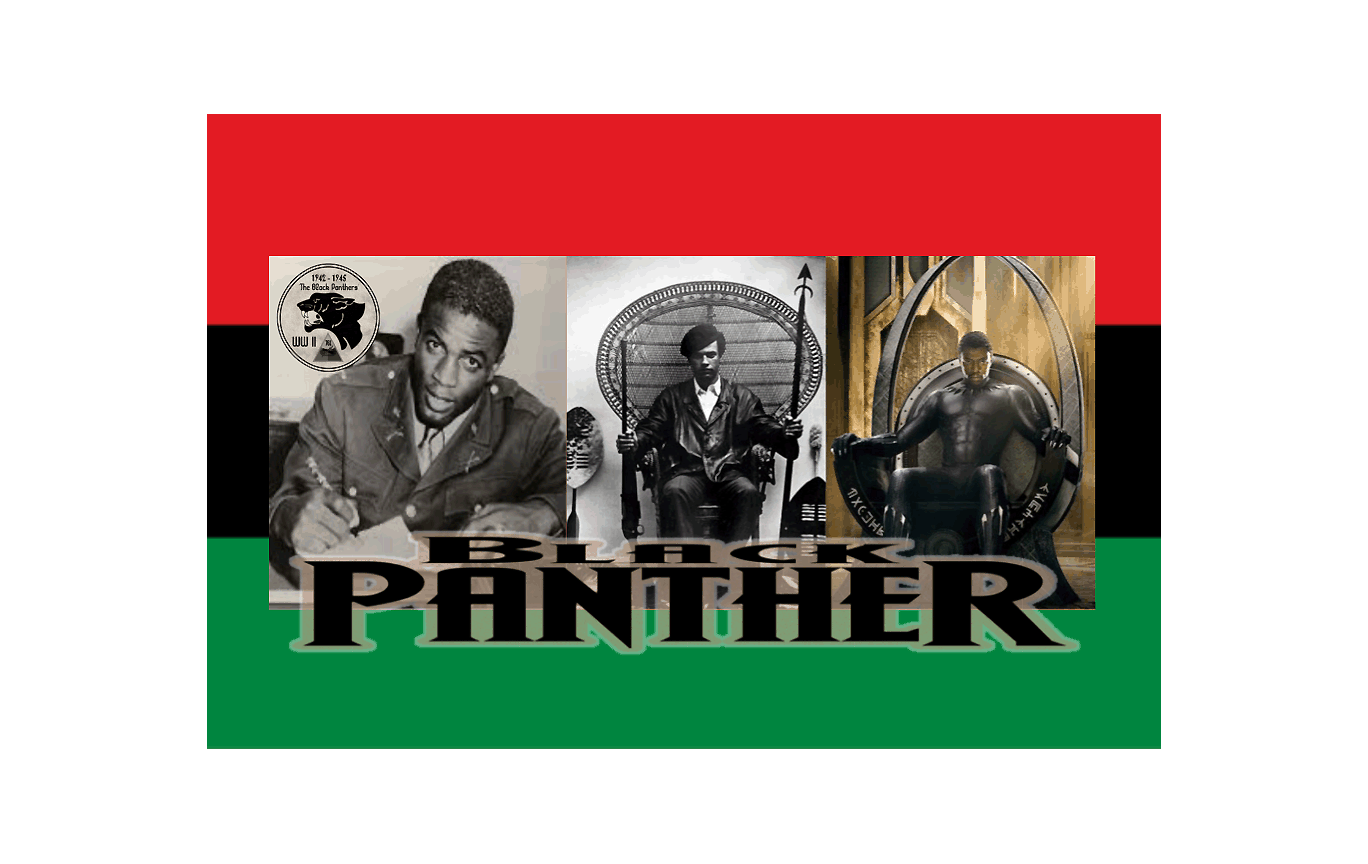The Bonds That Tie Together
We’ve connected the iconic Second Lieutenant Jackie Robinson, tapped to be the first junior officer of the 761st Tank Battalion with A promotional film poster released last summer depicting T’Challa, king of Wakanda, posed regally in an elaborate chair emphasized the overlap—earning immediate comparisons to one of the BPP’s most iconic images: co-founder Huey Newton enthroned on a wicker peacock chair gripping a spear in one hand and a shotgun in the other.

The connections being drawn between the 761st Tank Battalion, Black Panther and the Black Panther Party reflect the intersections between art, comic books, music and history. The Black Panther, who debuted in July 1966 as a part of the Fantastic Four comic book series, and the Black Panther Party gives us almost 52 years of time line, but if we include the 761 Black Panther Battalion, that’s 76 years to dialogue-on.
#Myron V. Cotton #Richard Gant and #Jason Williams
Richard Gant is an American actor.
https://t.co/cUqws6RbVI pic.twitter.com/S2HyuKLHye— Myron V. Cotton (@CottonEnterpris) March 10, 2018
The photo of Newton enthroned in the chair was taken at civil rights lawyer Beverly Axelrod’s home. Scholar Jane Rhodes described how Panther leader Eldridge Cleaver carefully staged the photo to include African symbols, to appeal to Black communities during a time of upsurge in pride in racial heritage. BPP co-founder Bobby Seale once explained that “this is really what Huey P. Newton symbolized with the Black Panther Party—he represented a shield for Black people against all the imperialism, the decadence, the aggression and the racism in the country. That’s what Huey P. Newton symbolized with us. That’s the way we projected it.”
Newton was arrested in October 1967 after a late night melee resulted in the death of a police officer and his own hospitalization with a bullet wound. Newton began a fight for his life, physically and to avoid the electric chair, and the Free Huey movement was born as the Panthers rallied supporters and argued that they had been targeted for police surveillance and harassment because of their radical politics.
Newton was incarcerated a few short months after the photo was taken; it became, in the words of Rhodes, “a powerful tool in Newton’s struggle for survival.” The photo served as an indispensable aid to the growth of the Free Huey movement due to the strength, power and resistance the imagery embodied. It was sold on posters and buttons and seized upon by the press. And it graced many Panther offices.
On September 10, 1968—two days after Newton escaped the death penalty and was sentenced for involuntary manslaughter—two off-duty police officers shot up the windows of the Panthers office in Oakland. The image of the bullet-riddled glass, with holes aimed squarely at Newton’s image, was widely circulated as a reminder of the ongoing struggle against police violence. This history informs the continued resonance of Newton’s poster at a time when the news is filled with stories of police bullets ripping through black and brown bodies.
Before The Two Oakland Black Panther Stories
The 761st, who called themselves the Black Panthers, was activated in 1942 and spent more than two years in training, despite the fact that white tank battalions were sent off to fight after only a few months’ training. At first they were trained in light Stuart tanks, but eventually they were given medium Sherman tanks and they made the best of their extended training.
Jackie Robinson, who would later go on to to integrate baseball, served as a First Lieutenant in the 761st until he was court-martialed for refusing to sit in the back of a bus. He was acquitted, but was then transferred to the 758th battalion.
Jackie Robinson During the War

Patton: Welcome, Kind Of
Finally, the 761st Tank Battalion, with its six white officers, thirty black officers and 676 black enlisted men, was shipped off to France and landed at Omaha Beach in October 1944. General Patton, Commander of the Third Army needed all the tanks he could get. The 761st’s training record, rated as “superior”, convinced him to give them a chance, despite his reservations. Before going into combat, he addressed them:
“Men, you’re the first Negro tankers to ever fight in the American Army. I would never have asked for you if you weren’t good. I have nothing but the best in my Army. I don’t care what color you are as long as you go up there and kill those Kraut sons of bitches. Everyone has their eyes on you and is expecting great things from you. Most of all your race is looking forward to your success. Don’t let them down and damn you, don’t let me down.”
M4 Tank Machine-Gunner

761st Tank Battalion: Patton’s Panthers Would Not Quit
By Charles W. Sasser
A cold January rain drizzled onto the rolling red-dust hills of central Oklahoma the day Ruben Rivers walked to war. There were those in the little Negro community of Holtaka who insisted this was a white man’s war and that Negroes didn’t belong in it. (Negro was the correct term during WWII). The only reason Negroes were invited was so they could cook for the white man and clean up after him while he did the fighting. Ruben didn’t see it that way. This was his country too.
Prior to WWII, assumptions about the inferiority of black soldiers as combat troops dominated military thinking and supported a policy of segregating blacks into support and service units to provide cooks, stevedores, truck drivers, orderlies and other noncombat personnel. Only five black commissioned officers served in the army in 1940, three of whom were chaplains.
“In a future war,” said Colonel Perry L. Miles, “the main use of the Negro should be in labor organizations.”
Even then-Colonel George S. Patton Jr. had little confidence in black soldiers. In a letter to his wife, he wrote, “A colored soldier cannot think fast enough to fight in armor.”
Ruben Rivers and the Negroes of the 761st Tank Battalion, the first to go to war in armor, were to change those assumptions as they engaged the enemy for 183 straight days in six European nations. No other unit fought for so long and so hard without respite.
In October 1944, General George Patton, who had initially disparaged black soldiers, sent a message to the War Department requesting more tankers, the best available. The only tank unit left was Negro—the 761st. The Black Panthers.
“Who the **** asked for color?” Patton shot back in typical salty style. “I asked for tankers.”
The 761st linked up with Patton’s Third Army near Nancy, France, on October 28. The front lines lay only a few miles ahead. Suddenly, a bunch of quarter-ton Jeeps loaded with MPs and .50-caliber machineguns rolled in and took up strategic defensive positions. As the tankers stood at attention, a single Jeep and an armored scout car dashed to the head of the formation and stopped next to Colonel Paul Bates. (Bates was white; white officers commanded black troops during WWII). Everyone knew from the two ivory-handled pistols holstered at the man’s belt that this was the legendary General Patton. The three stars on his helmet and collar reflected the sunlight as he vaulted to the hood of the armored car.
Contrary to the movie Patton, it was to the black tankers of the 761st that Patton delivered his famous speech.
“Men, you are the first Negro tankers to ever fight in the American army,” he began. “I have nothing but the best in my army. I don’t care what color you are, so long as you go up there and kill the Kraut sonsofbitches. Everyone has their eyes on you, and is expecting great things of you. Most of all, your race is looking forward to your success. Don’t let them down, and, G—damn you, don’t let me down. They say it is patriotic to die for your country. Well, let’s see how many patriots we can make out of those German sonsofbitches.”
Patton was a man to be taken seriously.
“There is one thing you men will be able to say when you go home,” he concluded. ‘You may all thank God that thirty years from now when you are sitting with your grandson on your knee and he asks, ‘Grandfather, what did you do in World War II? you won’t have to say, ‘I shoveled shit in Mississippi.’”
At Guebling, France, on 19 November 1944, the 761st was directed to hold the line until reinforcements arrived. Ruben Rivers, now a staff sergeant and a TC (tank commander), had already won a Silver Star for bravery and was suffering from an infected wound. He refused nonetheless to be evacuated, although he could hardly walk.
Daylight slowly arrived, cold and frosty with thin crusts of sleet over snow. Out of the fog rumbled Jagdtigers, the heaviest of Hitler’s armor, monsters armed with fearsome 128mm SPA guns and MG-34 machineguns. The Tigers belched flame that seemed to scorch light out of the morning. German antitank positions concealed on the far side of a slope beyond hedgerows lit up the gray sky. Barrages of explosions stomped all over and around the intersection. Two Black Panther tanks were knocked out immediately, killing Bob Hammond and Roderick Ewing.
“Pull back, pull back, Panthers!” came an order from the company commander.
“I see them. We’ll fight them!” Rivers responded.
His tank darted from cover, side by side with the Sherman commanded by Sergeant Walter James. Outnumbered and outgunned, the two iron steeds charged, diverting the German onslaught long enough for Americans caught in the open to withdraw and regroup.
Rivers and James smashed through the hedgerows and up the slope toward the enemy, all guns blazing, like jousters on steel mounts. For a few minutes, the American Shermans held their own. They seemed to exist in a charmed atmosphere as they tore furiously through fiery blasts of light and smoke and as brilliant tracers of green bounced off their thick hides.
Then a high-explosive shell caught Rivers’s tank and cracked it like an egg shell. A second shell finished the job, striking the turret and almost ripping Rivers’ body into two parts. Rivers’ tank continued to smoke out there on the field of battle for the rest of the day as American forces rallied, repelled the attack, and secured Guebling.
The Black Panther from Oklahoma who would not quit was dead.
During the 183 days Patton’s Panthers, the 761st Tank Battalion, were in continuous combat, they participated in four major Allied campaigns, including the Battle of The Bulge. They inflicted more than 130,000 casualties upon the enemy. Eight black enlisted men received battlefield commissions, while 391 received decorations for heroism: 7 Silver Stars for Valor (three posthumously); 56 Bronze Stars for Valor; and 246 Purple Hearts. Three officers and 31 enlisted men were killed in action, and 22 officers and 180 enlisted men were wounded.
In 1997, 53 years after sacrificing his life on the battlefield, Sergeant Ruben Rivers was posthumously awarded the Medal of Honor. In 1998, the 761stTank Battalion (deactivated) received a Presidential Unit Citation, the highest award that a unit can receive.
On June 9, 2009, a stretch of Highway 9 running through Pottawatomie County, Oklahoma, where Ruben Rivers grew up, was named in his honor—U.S. Army SSG Ruben Rivers Highway.


